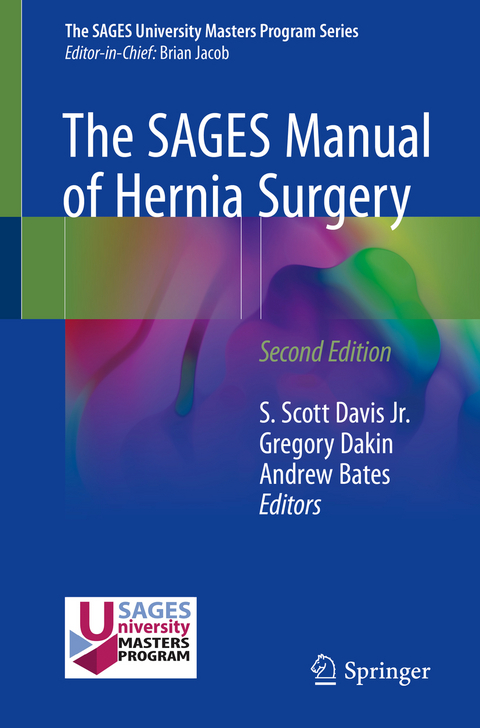
The SAGES Manual of Hernia Surgery
Springer International Publishing (Verlag)
978-3-319-78410-6 (ISBN)
This edition of the SAGES Manual of Hernia Surgery aligns with the current version of the new SAGES University MASTERS Program Hernia Surgery pathway. This manual serves as a curriculum for participants in the MASTERS Program as well as a modern text on hernia surgery for all learners. Hernia surgery is one of the fastest developing fields in general surgery today. There have been rapid advancements in hernia techniques in recent years, making most prior texts on the subject obsolete. These advancements involve significant evolution in both the techniques and strategies for hernia repairs, as well as the tools used to achieve these means. This text thoroughly addresses the multiple component separation techniques and options for locations of mesh repairs. It also discusses the revolution of hernia repair being facilitated by robotic surgery, which allows increased access to minimally invasive techniques for surgeons and thus increased access to minimally invasive surgicalrepairs for patients. This manual will be a valuable resource for interested surgeons to understand the variety of potential approaches to individual hernias, and to individually tailor the care of the hernia patient.
S. Scott Davis, Jr., MD, FACS Associate Professor of Surgery Department of Surgery Emory University Atlanta, GA Gregory F. Dakin, MD, FACS Associate Professor of Surgery Weill Cornell Medical College New York, NY 10065 Andrew Bates, MD Assistant Professor of Surgery Stony Brook University Hospital Stony Brook, NY
SAGES University MASTERS PROGRAM: Hernia Pathway. Laparoscopic Ventral Hernia Repair.- Masters Program Hernia Pathway: Laparoscopic Inguinal Hernia.- Hernia Materials-Fundamentals of Prosthetic Characteristics.- Permanent Prosthetics: Polypropylene, Polyester, ePTFE, Hybrid Mesh.- Biologic and Absorbable Prosthetic: When, Why, and Where are we Going.- Prosthetic Fixation Options.- How to Choose a Mesh in Hernia Repair.- Patient Comorbidities Complicating a Hernia Repair: The Preoperative Workup and Postoperative Planning.- Enhanced Recovery in Abdominal Hernia Repair.- Computed Tomography and Gross Anatomy of the Abdominal Wall (Including Planes for Mesh Hernia Repair).- Umbilical Hernia Options.- Bridging Versus Closing the Defect during MIS Ventral Hernia Repair: Pros and Cons.- Robotic Technique for Intraperitoneal Onlay Mesh (IPOM).- Ventral, Incisional and Atypical Hernias Using a Robotic Transabdominal Preperitoneal Approach.- Technique: Posterior Rectus Sheath.- Ventral Abdominal Hernia Repair Technique: External Oblique Release.- Techniques: Transversus Abdominis Release.- Robotic Transveruss Abdominis Release: Tips and Tricks.- Ventral Abdominal Hernia Repair: MIS Extraperitoneal Repaie Techniques: eTEP Rives, MILOS/EMILOS and Onlay MIS Repair.- Component Separations: Outcomes and Complications.- Botulinum Toxin in Abdominal Wall Hernia Repair.- Mesh Sutured Repairs of the Abdominal Wall.- Treatment of Parastomal Hernias.- Challenging Hernias: Spigelian, Flank Hernias, Suprapubic, and Subxiphoid.- Recurrent Ventral Hernia Repair.- Loss of Abdominal Domain.- Fixation vs. Fixation in MIS Inguinal Hernia Repair.- Open Techniques: Mesh and Non-Mesh Anatomical Repairs.- MIS Techniques: Lap TAPP and rTAPP.- MIS vs Open Inguinal Hernia for Uncomplicated Unilateral Hernia.- TAPP vs. TEP vs. rTAPP: What does the Evidence Show?.- Minimally Invasive Surgical Techniques for Inguinal Hernia Repair: The Extended-View Totally Extraperitoneal Approach (eTEP).- Inguinal Hernia Repair with Mini-laparoscopic Instruments.- The Cavernous Direct Inguinal Hernia.- Remoral Hernia and Other Hidden Hernias: Options and Strategies.- Strangulated Inguinal Hernia: Options and Strategies.- Groin Pain Syndromes in Athletes: Sports Hernia.- Chronic Pain After Inguinal Repair.- Intraoperative and Postoperative Complications of MIS Inguinal Hernia Repair.- Repair of Paraesophageal Hernia.- Repair of Congenital Diaphragm Hernias: Morgagni and Bochdalek.- Revisional Paraesophaeal Hernia: Tips and Tricks.- Establishing a Hernia Program.- Prevention of Abdominal Wall Hernias.- Hernias in the Pediatric Population.- Herniorrhaphy in Cirrhosis: Operative Approach and Timing.- Concurrent Hernia Repair with Gynecologic or Urologic Surgery: Pros and Cons.
"This will be used by trainees at all levels -- residents and fellows -- as well as practicing surgeons who wish to expand orsolidify their knowledge in the field. ... This is an extremely valuable and unique contribution. There is, currently, a plethora of books about hernia repair, but there is nothing like this book." (Carol Scott-Conner, Doody's Book Reviews, May 31, 2019)
| Erscheinungsdatum | 29.07.2018 |
|---|---|
| Zusatzinfo | XV, 680 p. 290 illus., 260 illus. in color. |
| Verlagsort | Cham |
| Sprache | englisch |
| Maße | 155 x 235 mm |
| Gewicht | 1050 g |
| Themenwelt | Medizinische Fachgebiete ► Chirurgie ► Viszeralchirurgie |
| Medizinische Fachgebiete ► Innere Medizin ► Gastroenterologie | |
| Schlagworte | Bioabsorbable Mesh • Femoral Hernia • Laparoscopic Ventral Hernia • Open Component Separation • Paraesophageal hernia • Permanent Mesh |
| ISBN-10 | 3-319-78410-2 / 3319784102 |
| ISBN-13 | 978-3-319-78410-6 / 9783319784106 |
| Zustand | Neuware |
| Haben Sie eine Frage zum Produkt? |
aus dem Bereich


